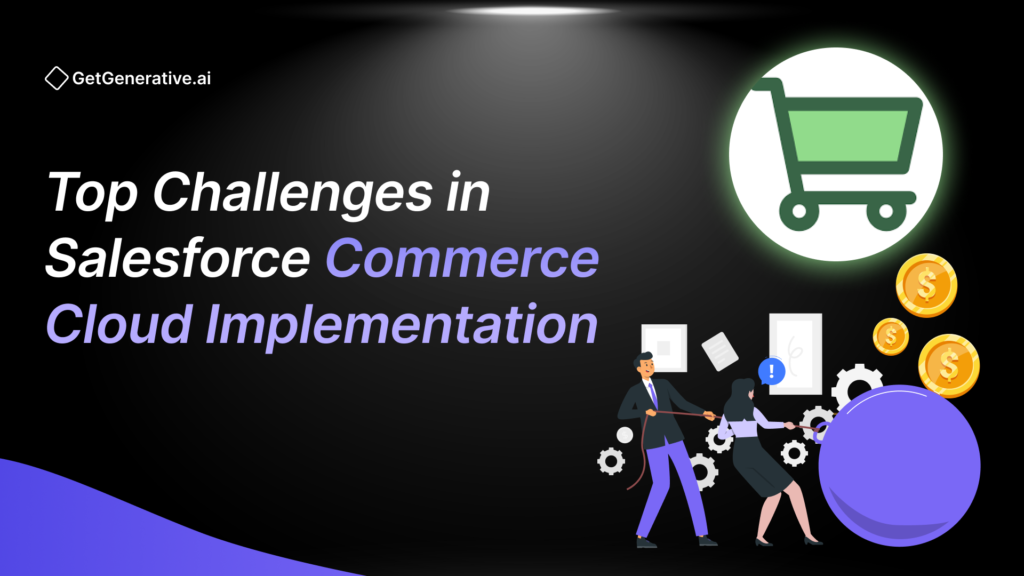Top Challenges in Salesforce Commerce Cloud Implementation
Salesforce Commerce Cloud stands as a powerful e-commerce platform crafted to deliver exceptional customer experiences across multiple channels. With its capabilities ranging from seamless omnichannel integration to cutting-edge personalization, it equips businesses to maintain a competitive edge in the market. However, leveraging this dynamic tool to its full potential requires careful planning and overcoming significant implementation challenges.
In this blog, we’ll unpack these hurdles, delve into real-world scenarios, and share actionable strategies to help you overcome them.
The Top Challenges in Salesforce Commerce Cloud Implementation
1. Data Migration Complexities
Transferring existing data into Salesforce Commerce Cloud is a significant hurdle, especially when dealing with diverse data formats and large volumes.
Challenge in Action:
Imagine a retailer using spreadsheets, legacy databases, and standalone CRM tools. Migrating this fragmented data into Salesforce, while maintaining accuracy, can lead to issues like duplicate entries, missing fields, and errors.
Solution:
- Audit and clean your data before migration.
- Use data management tools to map fields accurately.
- Implement a phased migration plan to minimize downtime.
2 Customization Complexity
Salesforce Commerce Cloud’s flexibility can lead to excessive customization, resulting in maintenance headaches.
Challenge in Action:
A fashion retailer customizes the platform for unique workflows but struggles with compatibility during updates, leading to delays and disruptions.
Solution:
- Focus on modular customizations.
- Leverage pre-built extensions whenever possible.
- Collaborate with Salesforce consultants for scalable solutions.
3. Integration Hurdles
Seamlessly connecting Salesforce Commerce Cloud with existing systems, like ERP or payment gateways, is crucial but challenging.
Challenge in Action:
A retailer’s ERP system uses outdated formats, causing compatibility issues with Salesforce Commerce Cloud.
Solution:
- Use tools like MuleSoft for integration.
- Test data mapping extensively.
- Rely on pre-built connectors to streamline the process.
4. User Adoption Resistance
Getting teams to embrace a new system often meets resistance, driven by fear of change and unfamiliarity.
Challenge in Action:
A sales team accustomed to manual processes struggles to adapt to Salesforce, leading to inefficiencies.
Solution:
- Offer comprehensive training tailored to varying skill levels.
- Encourage adoption with hands-on workshops and support.
- Highlight how Salesforce simplifies daily tasks.
Also Read – Salesforce Commerce Cloud Implementation Guide 2024
5. Budget and Time Overruns
Underestimating time and costs is a common pitfall during Salesforce Commerce Cloud implementation.
Challenge in Action:
A retailer faces unforeseen expenses due to additional customizations and integration complexities, delaying the project.
Solution:
- Develop a detailed project roadmap with contingencies.
- Set realistic budgets based on thorough risk assessments.
- Regularly review milestones to avoid scope creep.
6. Performance Optimization
Heavy customizations and inefficient coding practices can slow down the platform.
Challenge in Action:
An online retailer experiences delayed page load times due to complex business logic, impacting customer satisfaction.
Solution:
- Optimize database queries and code.
- Use caching and CDNs (Content Delivery Networks).
- Monitor performance metrics to address bottlenecks early.
7. Scalability Concerns
Rapid business growth can strain your system if scalability wasn’t planned during implementation.
Challenge in Action:
A retailer struggles with inventory management and high transaction volumes during peak seasons.
Solution:
- Invest in scalable infrastructure.
- Use load balancing to distribute traffic effectively.
- Monitor and adapt to evolving demands.
8. SEO Optimization
Salesforce Commerce Cloud’s URL structures and metadata settings can pose SEO challenges.
Challenge in Action:
A retailer struggles with low organic visibility due to duplicate content and non-optimized metadata.
Solution:
- Implement SEO-friendly URL structures.
- Optimize metadata and generate XML sitemaps.
- Use extensions to enhance SEO capabilities.
Also Read – Essential Features of Salesforce Commerce Cloud
Best Practices for Overcoming Challenges
1. Plan Thoroughly
Success starts with a detailed roadmap. Define clear objectives, timelines, and potential risks before implementation.
2. Leverage Expert Support
Certified Salesforce partners and consultants bring expertise to navigate complexities effectively.
3. Focus on Training
Equip your team with the knowledge to use Salesforce efficiently. Tailored training ensures higher adoption rates.
4. Test Regularly
Conduct comprehensive testing at every stage to identify and resolve potential issues before they escalate.
Conclusion
While implementation challenges may seem daunting, strategic planning, expert guidance, and continuous optimization can pave the way for success. By addressing these hurdles proactively, you can harness the full potential of Salesforce Commerce Cloud and thrive in a competitive market.
To learn more, visit GetGenerative.ai.
FAQs
1. How long does it take to implement Salesforce Commerce Cloud?
Implementation timelines vary based on complexity but typically range from 3 to 12 months.
2. Can I integrate Salesforce Commerce Cloud with my existing ERP system?
Yes, tools like MuleSoft and pre-built connectors can simplify ERP integrations.
3. What are the key benefits of Salesforce Commerce Cloud?
It offers scalability, personalization, omnichannel capabilities, and enhanced customer experiences.
4. How can I ensure user adoption during implementation?
Provide tailored training, highlight benefits, and offer ongoing support to your teams.
5. Is Salesforce Commerce Cloud scalable for growing businesses?
Absolutely. With proper infrastructure and load balancing, it can handle growth seamlessly.




